The aroma of expertly crafted traditional biryani dishes masterfully prepared, has the power to captivate even the most discerning palate, presenting a dish that is the ultimate expression of kitchen wizardry.
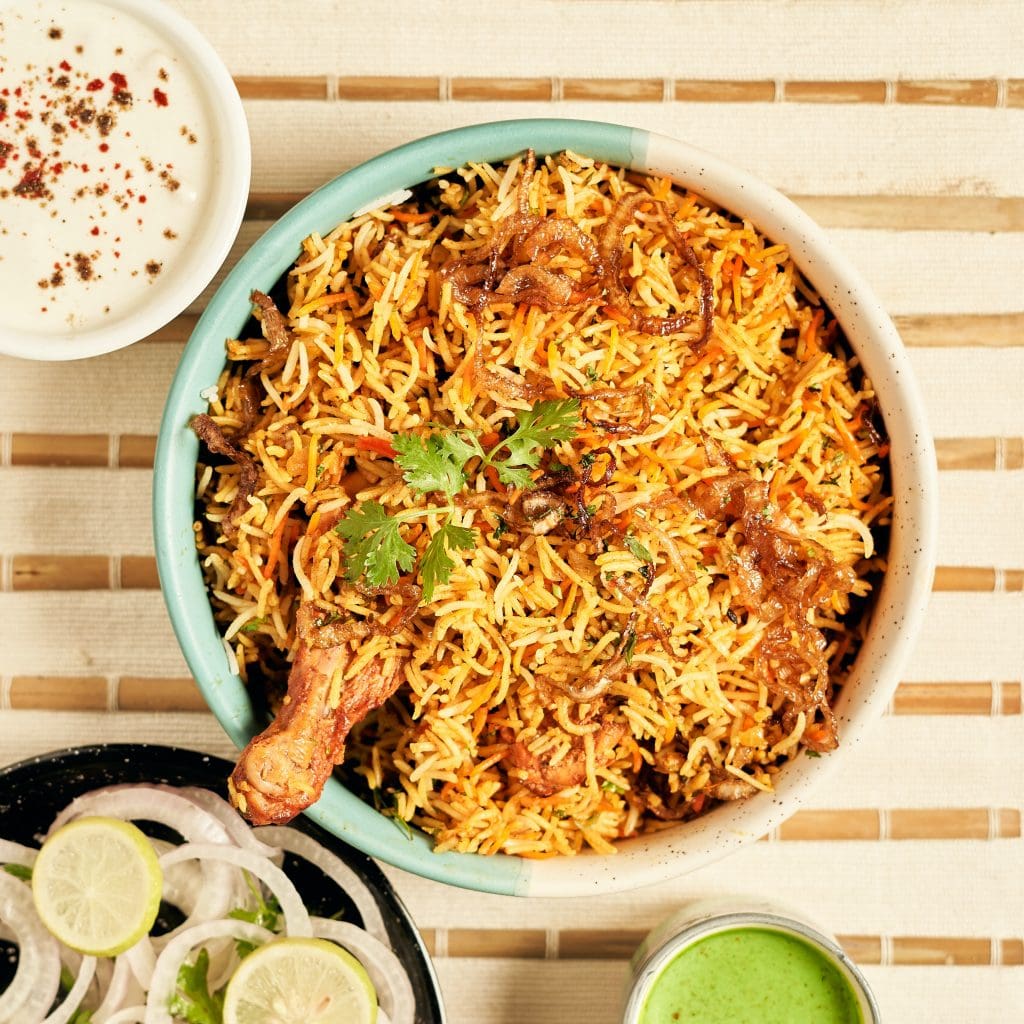
Image Credit: dhiraj jain via pexels
Take a flavourful journey through India with its biryani dishes, where every spoonful is an aromatic escapade that captures the essence of the country’s diverse culinary landscape. From the aromatic alleyways of Lucknow to the bustling streets of Hyderabad, India‘s culinary landscape is dotted with the rich tapestry of biryani dishes, each narrating tales of bygone eras, royal courts, and age-old traditions.
This introduction to the Biryanis of India invites you on a gastronomic voyage, exploring a dish that is a marvel of the culinary world.
Biryani, much more than a mere dish, is an embodiment of India’s diverse culture, a melange of flavours inherited from sultans, traders, and local chefs. The treasures of India’s biryani legacy showcase the distinctive varieties that have captivated palates and withstood the test of time.
Biryani – a well-known rice delicacy
Biryani, India’s renowned rice delicacy, traditionally features mutton, but chicken versions have also gained immense popularity. Additionally, regional variations of this dish abound. The core of biryani comprises marinated meat and rice seasoned with spices like cardamom, cinnamon, and cloves.
Other frequent mutton or chicken biryani ingredients include yoghurt, cashews, saffron, onions, and mint leaves. The final creation is often complemented with raita, a yoghurt-based side, and chutney. Often the centrepiece at Indian events like weddings, parties, and festivals, biryani has garnered global admiration for its unique taste and aroma.
Beyond its scrumptious taste, biryani is nutritionally balanced. The rice supplies carbs for energy, the meat offers protein, and the accompanying vegetables deliver vital vitamins and minerals. The spices, apart from amplifying the flavour, bring forth health benefits, including anti-inflammatory properties.
The preparation of biryani varies with personal tastes and regional traditions. While some opt for ghee (clarified butter), others might choose oil. Spicing can be tailored to one’s liking. For example, the preparation of Hyderabadi biryani stands out, as the meat is marinated in yoghurt and spices prior to being layered with rice. In India, biryani is predominantly prepared using the Dum Pukht method, where it’s cooked in a sealed pot. Yet, each region boasts its distinctive biryani rendition and preparation technique.
The Essence of Hyderabadi Biryani
Hyderabadi Biryani, a celebrated dish from Hyderabad, India, masterfully blends the traditions of Hyderabadi and Mughlai cuisines. This iconic delicacy, which traces its roots back to the royal kitchens of the Nizams, showcases two prominent versions: Pakki and Kacchi.
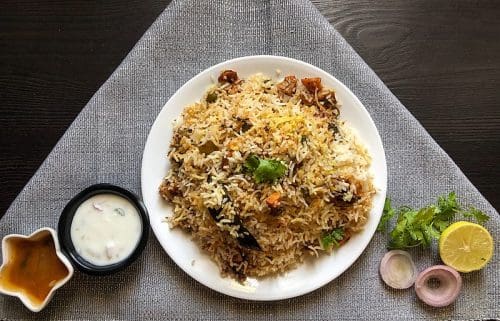
Image Credit: Mahi Tatavarty, CC BY-SA 4.0 via Wikimedia Commons
The Pakki style involves layering cooked meat and basmati rice. In contrast, the Kacchi variant places uncooked marinated meat, be it chicken or lamb, between layers of saffron-infused basmati rice, adorned with onions and dried fruits. Both styles undergo a slow-cooking process inside a dough-sealed earthen pot placed over a charcoal grill. The result is a deeply aromatic, flavorful, and indulgent biryani that stands as a testament to the region’s rich culinary heritage.
The Royal Flavors of Awadhi Biryani
Hailing from the grand courts and royal kitchens of Awadh, historically known as the present-day northeastern part of Uttar Pradesh, the Awadhi or Lucknowi Biryani stands as a testament to the region’s opulent culinary heritage.
Distinctly known as the ‘pakki biryani’, this variant uses a unique ‘dum’ style of cooking, where cooked meat and partially cooked rice is layered, allowing them to simmer together, ensuring each grain of rice is infused with the flavoursome juices of the meat.
Often referred to as Lucknowi Biryani, this dish is more subtle and fragrant compared to its robust southern counterparts. Moreover, the use of specific Awadhi spices, rose water, and kewra (screw pine) sets it apart, offering a delicate and aromatic dining experience. It’s not just a meal; it’s a journey back to the lavish feasts of the Nawabs of Awadh.
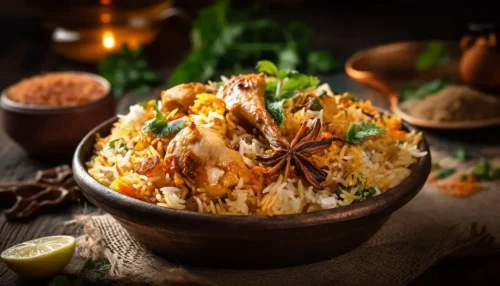
Image Credit: Vecstock via freepik
The Melting Pot: Thalassery Biryani
Steeped in a rich tapestry of maritime trading history, the coastal town of Thalassery in northern Kerala boasts a unique culinary palette that beautifully melds Arabian, Persian, Indian, and European culinary traditions.
One of the shining stars of Thalassery’s diverse cuisine is the famed Tellicherry Biryani. Unlike the typical biryanis that use basmati rice, Thalassery Biryani employs Kaima rice, a short-grain rice known for its rich aroma. Delicately spiced and combined with succulent chicken, this biryani stands out in taste and texture. Often referred to as Kerala Biryani due to its distinctive place in Kerala’s gastronomic landscape, Thalassery Biryani isn’t just a dish—it’s a flavorful testament to the region’s rich culinary heritage and trading legacy.
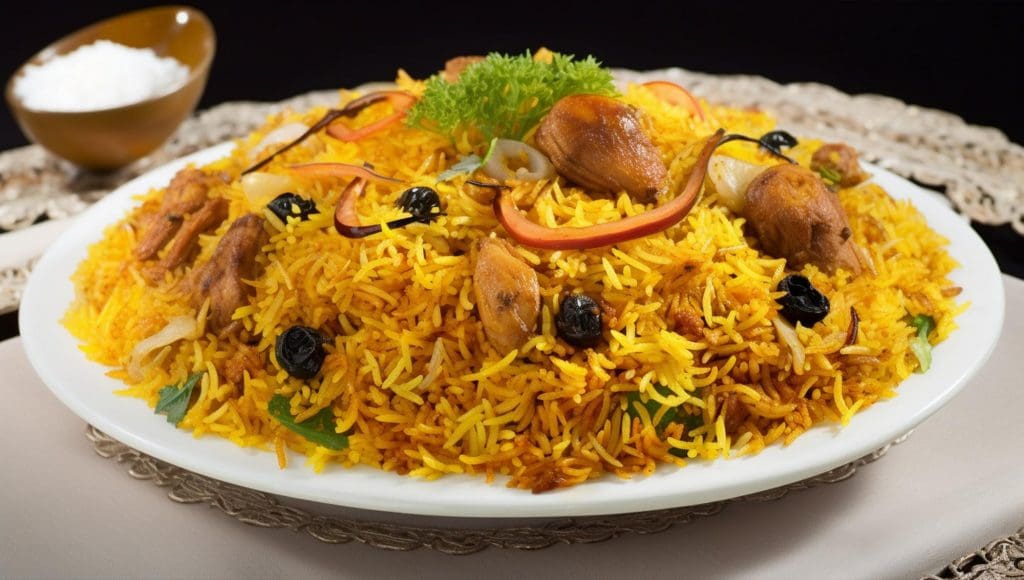
Image Credit: johnniedavid12412 via freepik
Kolkata Biryani: A Lucknowi Legacy Reimagined
While its roots trace back to the regal kitchens of Lucknow, Kolkata Biryani has carved a niche for itself, celebrating the ethos of the city it’s named after.
This adaptation of the Lucknowi Biryani has undergone a culinary evolution to suit the palate of Kolkata’s vibrant populace. Characterized by its lightly tinted yellow rice, generously layered with yogurt-marinated meat, the Kolkata Biryani incorporates unexpected, yet delightful additions of soft-boiled eggs and potatoes.
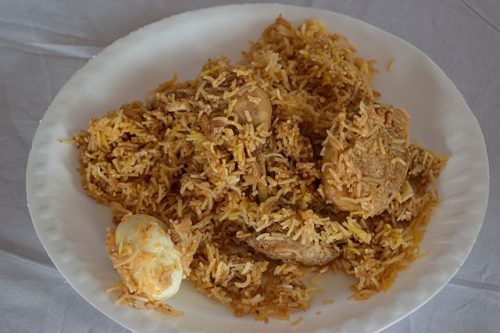
What truly sets it apart, though, is its nuanced flavours – a gentle balance of savoury with an understated sweetness, and a judicious use of spices that allows each ingredient to shine. In every bite, one can taste both its regal legacy and the unique charm of Kolkata.
Ambur and Chettinad Biryani: The Tamil Treasures
In the southern heartland of India, biryani takes on flavours and tales as rich as its history. Ambur Biryani, also revered as Arcot Biryani, carries the legacy of the Mughal kitchens that thrived in the region.
The 18th-century Nawabs of Arcot, who prominently ruled the Carnatic region of South India, made Arcot their strategic hub. It was within their royal kitchens that the recipe of Ambur Biryani was meticulously crafted. This biryani uses Seeraga samba rice, a variety peculiar to the region, harmoniously mixed with meat marinated in curd and adorned with mint and coriander, encapsulating the essence of Tamil Nadu.
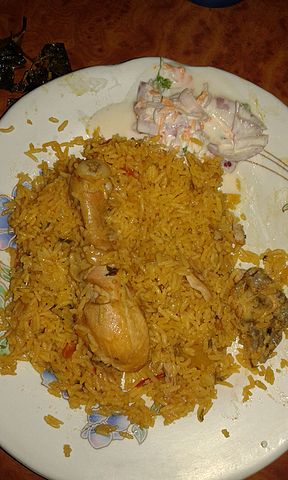
Parallelly, Tamil Nadu introduces another culinary marvel, the Chettinad Chicken Biryani. A fiery sibling to the more muted Dum Biryanis, this dish brims with bold spices like kalpasi (stone flower), star anise, and Marathi moggu (dried flower pods). Occasionally, this biryani chicken recipe sports a concoction of tomato and mint puree amalgamated, and the inclusion of coconut milk introduces a creamy, tantalizing twist to this aromatic rice dish.
Both biryanis, in their unique ways, exemplify the rich, diverse culinary traditions of Tamil Nadu.
Memoni Biryani: A Spicy Legacy of the Gujarat-Sindh Region
Emerging from the rich culinary traditions of the Memon community in the Gujarat-Sindh regions of India and Pakistan is the tantalizingly spicy Memoni Biryani.

Unlike other biryanis that boast a vibrant orange hue, the Memoni variant is distinctive in its appearance, largely due to its restrained use of food colouring. This conscious choice allows the deep, natural shades of the meat and spices to remain unmasked, presenting a dish that is visually as arresting as it is flavourful.
Prepared predominantly with succulent lamb, creamy yoghurt, crisply fried onions, and potatoes, it strikes a balance by using fewer tomatoes, creating a fiery yet harmonious blend that stands testament to the Memon community’s rich culinary expertise.
Bhatkali Biryani: A Coastal Delight with Persian Roots
Nestled within the coastal contours of Karnataka lies Bhatkal, the birthplace of the distinct Bhatkali Biryani, a gem in the crown of Navayath cuisine.

The genesis of this dish can be traced back to the Persian merchants who sailed to these shores, introducing an array of kebabs and flatbreads. But their most cherished legacy remains the Bhatkali biryani. Unlike its more colourful counterparts, the Bhatkali version champions simplicity: white rice with occasional orange flecks.
Yet, its flavours are anything but simple. Layers of aromatic rice envelop meat steeped in a robust masala of onions and green chillies, resulting in a biryani that’s both fiery and rich, capturing the essence of its coastal Persian lineage.
Kalyani Biryani: Hyderabad’s Humble Culinary Gem
From the historic terrains of what was once Hyderabad Deccan emerges the Kalyani Biryani, often fondly termed the “poor man’s” Hyderabadi biryani.
At the heart of this biryani is buffalo meat, meticulously diced into small cubes and infused with a medley of spices. Ginger, garlic, red chillies, turmeric, cumin, and coriander powder converge with generous amounts of onions and tomatoes to form the base. Initially prepared as a rich curry, the meat then dances with rice in a slow simmer, ensuring every grain absorbs the robust flavours. The result is a humble yet flavorful biryani, exemplifying the rich culinary traditions of Hyderabad.
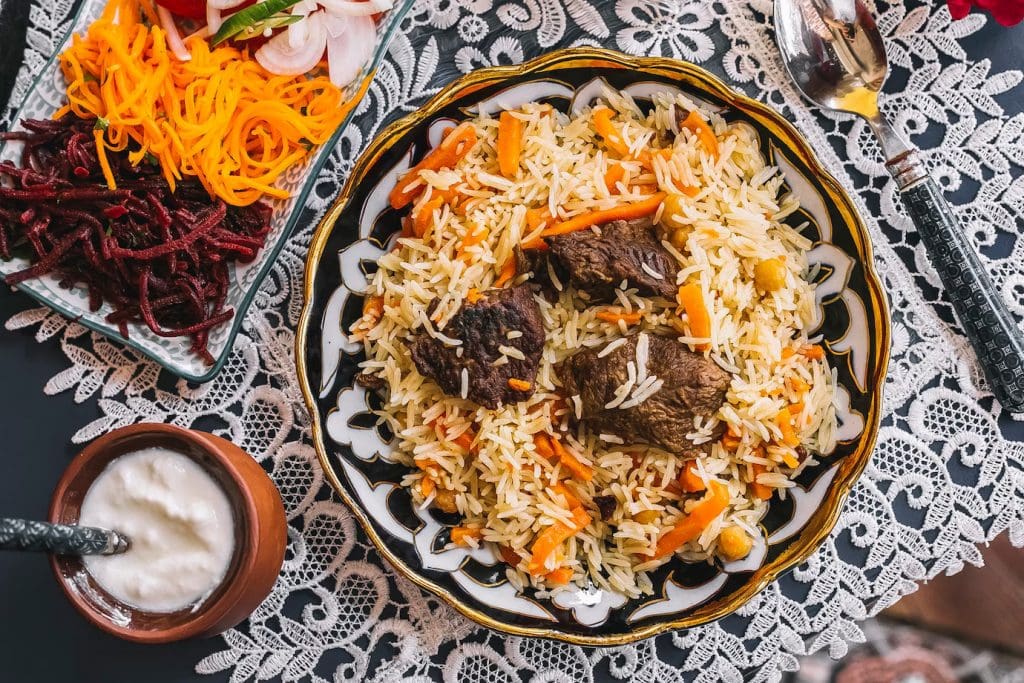
Image Credit: stocking via freepik
Bombay Biryani: The Melodious Mélange of Mumbai
Amidst the diverse biryani landscape of India, the Bombay Biryani emerges as a harmonious blend of distinct flavours, capturing the eclectic spirit of Mumbai.
This particular rendition features aromatic basmati rice layered beautifully with potatoes and succulent pieces of meat – be it chicken, mutton, lamb, or even a medley of vegetables. The inclusion of fried onions, fresh mint leaves, and intriguing dried plums adds layers of complexity. Each bite is a flavorful journey, with the rice and meat cooked to perfection amidst a symphony of spices.
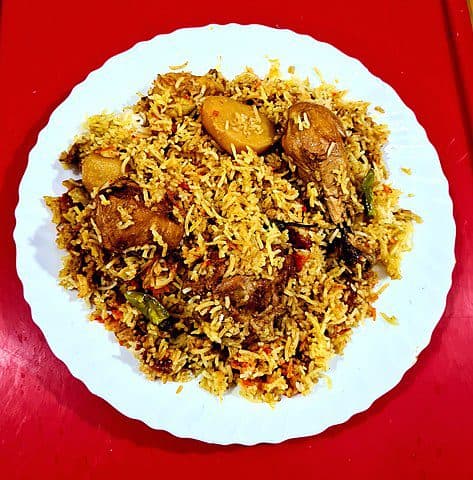
The dish’s unique charm lies in its nuanced sweetness, derived from dried plums, kewra essence, and golden fried onions. As a final touch, the biryani is drizzled with melted ghee, sealing in its aromatic essence. Traditionally accompanied by a cool raita and crisp salad, Bombay Biryani is a gastronomic salute to Mumbai’s vibrant culinary tapestry.
Rawther Biriyani: A Fiery Fusion of Tradition
Dive into the tantalizing world of Rawther Biriyani, a dish that commands attention with its vibrant dark red hue, a testament to the lavish use of fresh tomatoes and the fiery touch of Kashmiri red chilli powder.
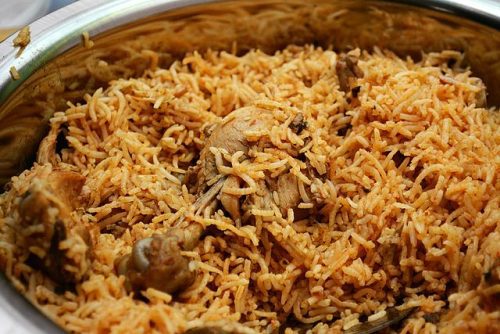
Image courtesy Rupamdas75 via Wikipedia Commons
At the heart of this biriyani lies the Jeerakasala rice, an aromatic short-grain variety, which cradles the spices and ingredients beautifully. Rooted deeply in the culinary traditions of Tamil Nadu and Kerala, this spicy dum biriyani holds a special place among the Rawther Muslim communities of Coimbatore and Palakkad.
Yet, its allure doesn’t stop at regional boundaries. Rawther Biriyani, with its robust flavours and fragrant allure, has begun captivating taste buds far beyond its traditional communities, making it a rising star in the vast galaxy of biriyani dishes.
Read More: Latest



